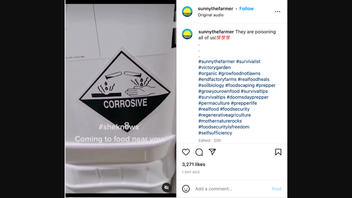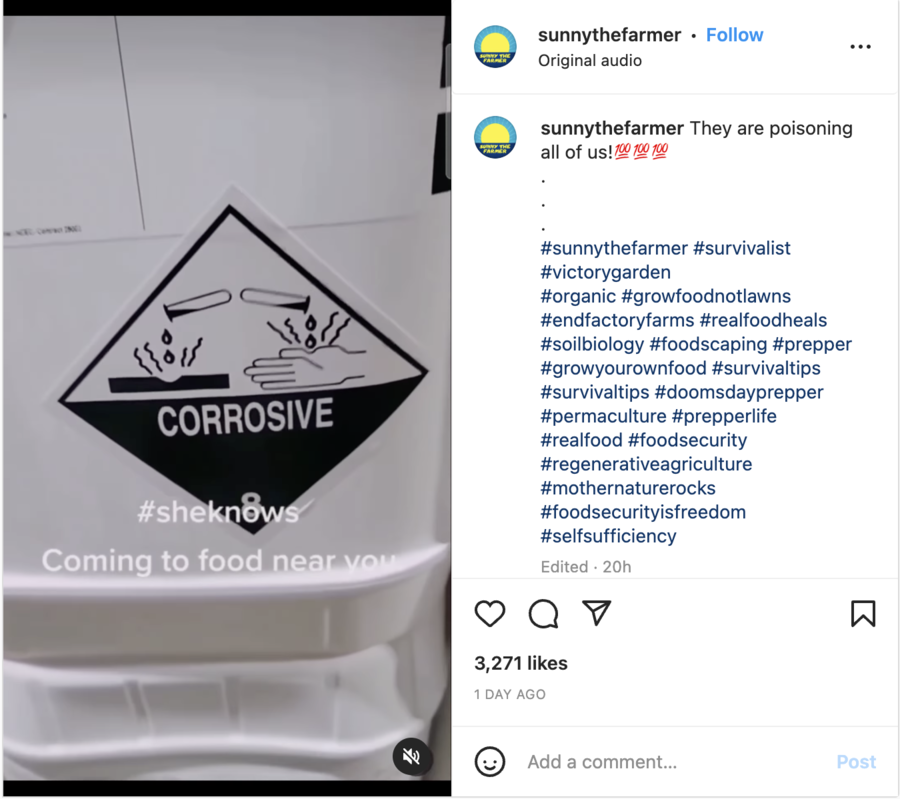
Is a Parmesan cheese flavor additive toxic? No, that's not true: Two food science experts told Lead Stories it can be dangerous in large amounts because it contains butyric acid, but the amount of the acid allowed in Parmesan is no cause for alarm. Butyric acid naturally occurs in the body and aids in digestion.
The claim, which appeared on Instagram on January 5, 2023, has a video that plays rapper J. Cole's music video "She Knows." The video shows footage of industrial-grade containers labeled with stickers that read "Corrosive," "Butyric Acid" and "Artificial Parmesan Cheese Flavor." The text overlay is "#sheknows Coming to food near you."
The video was captioned with:
They are poisoning all of us!💯💯💯 #sunnythefarmer #survivalist #victorygarden
#organic #growfoodnotlawns #endfactoryfarms #realfoodheals #soilbiology #foodscaping #prepper #growyourownfood #survivaltips #survivaltips #doomsdayprepper #permaculture #prepperlife #realfood #foodsecurity #regenerativeagriculture #mothernaturerocks #foodsecurityisfreedom #selfsufficiency
This is what the Instagram post looked like at the time of writing:
(Source: Instagram post screenshot taken on Mon Jan 9 14:24:27 2023 UTC)
The video does not make an explicit claim, but it implies that Parmesan cheese flavoring is toxic because the containers it's stored in are labeled "corrosive."
Lead Stories spoke to two food science experts about this implied claim: Melissa Wright, the director of the Food Producer Technical Assistance Network at Virginia Tech in Blacksburg, Virginia; and Lynne McLandsborough, the head of the Department of Food Science at the University of Massachusetts Amherst in Amherst, Massachusetts.
Wright said in a January 9, 2023, email that butyric acid, the label seen in the video, should not worry people because the human body produces it, and the acid naturally occurs in many foods, like butter, vegetable oils, kombucha and human breastmilk. Butyric acid is a component of Parmesan flavoring, Wright said, because it gives the cheese its "natural funky, footy odor." It can also be taken as an aid for digestion. Its over-the-counter name is sodium butyrate.
The Food and Drug Administration (FDA), which regulates the use of food additives in the United States, identifies butyric acid as a flavoring substance that generally is considered safe.
Food products include around a 0.01 to 0.05 percent concentration of Parmesan cheese flavoring, Wright said. The usage limit for the acid, which can make food products quite oily, "is the point at which the consumer is disgusted by the product, which would be well in advance of the point at which the consumer would be harmed by the product."
In a January 10, 2023, email, Wright explained that without seeing the Material Safety Data Sheet (now known as a Safety Data Sheet) for the flavoring in the Instagram video, there is no way to know the concentration of butyric acid in the flavoring. The manufacturer or importer of a chemical usually prepares a Safety Data Sheet to provide information about the hazards of working with a chemical and safety procedures.
Wright added that if a person ingested or spilled on their skin the large amounts of artificial Parmesan flavoring seen in this video, there would be significant side effects like skin irritation or even burns. For this reason, under the U.S. Department of Transportation's (DOT) rules, the containers have a warning label that says "corrosive."
Lead Stories asked how much butyric acid would be considered harmful to humans. Wright wrote:
There is no occupational exposure limit for butyric acid. The DOT placard on the flavoring showing that it is a corrosive material in packing group III means that if skin is directly exposed to the flavoring, it would take greater than 60 minutes but less than 4 hours for the skin to be destroyed by the corrosivity. In comparison, highly concentrated acetic acid is packing group II, which is considered a moderate hazard.
McLandsborough provided similar but slightly different insights about the claim in a January 9, 2023, email. She wrote that butyric acid is "expected" in the human body and that it forms in the colon when dietary fiber is consumed. The acid, in fact, acts as "an energy source" for "cells surrounding the colon" and, she added, "has been shown to have anti-inflammatory properties in the colon."
Additional Lead Stories fact checks of claims about cheese can be read here, here and here.













